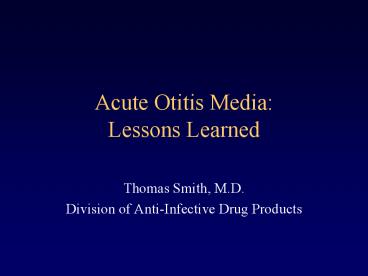Acute Otitis Media: Lessons Learned - PowerPoint PPT Presentation
1 / 22
Title:
Acute Otitis Media: Lessons Learned
Description:
Acute Otitis Media: Lessons Learned Thomas Smith, M.D. Division of Anti-Infective Drug Products 1998 Draft Guidance: Study Considerations Statistically adequate and ... – PowerPoint PPT presentation
Number of Views:521
Avg rating:3.0/5.0
Title: Acute Otitis Media: Lessons Learned
1
Acute Otitis MediaLessons Learned
- Thomas Smith, M.D.
- Division of Anti-Infective Drug Products
2
1998 Draft GuidanceStudy Considerations
- Statistically adequate and well-controlled
multicenter trial - Rigid case definitions with specific subjective
and objective diagnostic and effectiveness
parameters clearly defined - Baseline tympanocentesis need not be performed
tap of failures strongly encouraged to document
inadequately treated pathogens
3
1998 Draft GuidanceStudy Considerations
- Tympanocentesis trial
- Silent on comparative vs. noncomparative
- Establish acceptable outcome in at least
- 25 patients with H. influenzae
- 25 patients with S. pneumoniae
- 15 patients with M. catarrhalis
- Tap of failures strongly encouraged
4
Example Clinical-only Trial
- Double-blind, double-dummy, randomized trial
- 350 patients enrolled from 9 U.S. sites
- Ages 6 months-12 years
- 60 gt2 years mean age 2.7 years
5
Clinical-only TrialMITT Outcomes
- Study Drug Comparator 95 CI
- EOT Success 139/160 142/161 ()
(87) (87) -9.2, 6.5 - TOC Cure 114/151 116/154
- () (75) (75) -10.2, 10.5
- EOTDay 12-16 TOCDay 28-32
6
Example Tympanocentesis Trial
- Open-label, noncomparative trial with baseline
tympanocentesis - 248 patients enrolled from 22 U.S. and Latin
American sites - Ages 6 months-12 years
- 65 gt2 years mean age 3.4 years
- 127 (51) with positive cultures
7
Tympanocentesis TrialOutcomes by Pathogen
- EOT Success () 95 CI
- Overall 213/240 (89) 84.5, 93.0
- Pathogen
- S. pneumoniae 70/76 (92)
85.4, 98.8 - H. influenzae 30/42 (71)
56.3, 86.3 - M. catarrhalis 10/10 (100)
95.0, 100 - EOTDay 8-12
8
Comments from Advisory Committee, November 2001
- Limitations of clinical-only trials
- Issues with microbiologic data
- Age distribution of patients
- Need for revision of draft guidance
9
Pediatric Infectious Disease Journal Newsletter,
February 2002
- The supporting studies for these two regimens
have shortcomings, similar to studies of other
therapeutic agents in acute otitis media. It is
time for the FDA to establish strict criteria for
conducting clinical trials in patients with AOM
if a new antibiotic is to be approved for therapy.
10
Pediatric Infectious Disease Journal Newsletter,
February 2002
- Such clinical trials should include a
predominance of children younger than 2 years, a
tympanocentesis at diagnosis to establish
etiology, a repeat tympanocentesis at 4-5 days in
a subset of patients to establish bacteriologic
cure or a repeat ear tap in patients who are
considered clinical failures, and follow-up
evaluation at 10-14 days as the primary clinical
endpoint.
11
Issues for Discussion
- Value of comparative studies with diagnostic
tympanocentesis - Role of clinical-only studies
12
1998 Draft GuidanceStudy Considerations
- Pathogens listed in label
- Acceptable eradication rates
- If product fails to have acceptable clinical and
microbiologic effectiveness against all 3 major
pathogens, it should be listed only for those it
has eradicated restricted listing as not a
product for first line therapy - Restriction is based on empiric nature of
treatment and need for first-line therapies to be
effective against all common pathogens
13
Example Pathogen Labeling
- Indications
- Otitis media caused by H. influenzae, M.
catarrhalis, S. pyogenes - ( fewer than 10 infections)
- Clinical Studies
- Response rate of S. pneumoniae to cefixime
approximately 10 lower and that of H. influenzae
or M. catarrhalis approximately 7 higher than
rates of these organisms to active control drugs
14
Example Pathogen Labeling
- Indications
- Acute bacterial otitis media due to H.
influenzae, M. catarrhalis, or S. pyogenes - NOTE Although ceftibuten used empirically was
equivalent to comparators in the treatment of
clinically and/or microbiologically documented
acute otitis media, the efficacy against S.
pneumoniae was 23 less than control. Therefore,
ceftibuten should be given empirically only when
adequate antimicrobial coverage against S.
pneumoniae has been previously administered. - Clinical Studies
15
Issues for Discussion
- Demonstration of efficacy against all major
pathogens - Inclusion of pathogens in label
16
1998 Draft GuidanceInclusion Criteria
- Clinical-only trials ordinarily should not enroll
children less than 6 months old - No recommendations about age distribution in
studies - Problem unrepresentative study populations
- Examples
17
1998 Draft GuidanceExclusion Criteria
- Tympanostomy tubes
- Otitis externa
- Systemic anti-infective therapy
- Clinical-only 7 days prior to enrollment
- Clinical/micro 3 days prior to enrollment
- Antimicrobial prophylaxis for recurrent OM
18
Issues for Discussion
- Inclusion criteria age distribution of children
enrolled in trials, other methods of capturing
population of greatest interest - Exclusion criteria for clinical/micro studies,
permit enrollment of recently-treated patients,
patients receiving prophylaxis
19
1998 Draft GuidanceEvaluation and Outcome
- Evaluations
- Entry
- On-therapy (3-5 days) strongly recommended
- End-of-treatment optional
- Test-of-cure (2-4 weeks after entry)
- Late post-treatment optional
- Outcome
- Primary endpoint is test-of-cure visit
20
Advisory Committee, January 2001
- Relevant clinical test of cure is at end of
therapy later follow-up is important secondary
endpoint - To assess microbiologic response, most
informative repeat taps are on therapy, followed
by at time of clinical failure
21
Summary Issues for Discussion
- Value of comparative studies with diagnostic
tympanocentesis - Role of clinical-only studies
- Demonstration of efficacy against all major
pathogens - Inclusion of pathogens in label
22
Summary Issues for Discussion
- Inclusion criteria age distribution of children
enrolled in trials, other methods of capturing
population of greatest interest - Exclusion criteria for clinical/micro studies,
permit enrollment of recently-treated patients,
patients receiving prophylaxis































